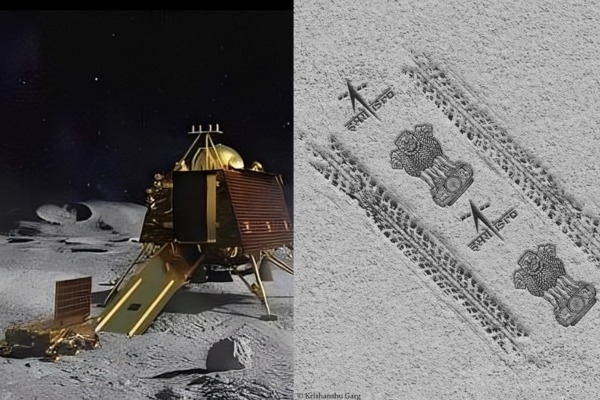India`s emblem etched on moon for eternity! ISRO's Pragyan Rover takes first walk on Moon; But what will it do?
Pragyan will check the chemical composition of the lunar surface, and examine the lunar soil and rocks. Pragyan will carry out key investigations for several elements on the surface, like magnesium, silicon, potassium, calcium, iron and more.
Total Views |
Writing their name in history by successfully landing its Vikram Lander on the south pole of Lunar land, now Indian Space Research Organisation's rover Pragyan has taken a walk on the moon, leaving an impression of India's National emblem and ISRO's logo on the surface of the moon.

"Made in India, Made for the Moon, The Ch-3 Rover ramped down from the Lander and India took a walk on the moon!" Isro tweeted.
India`s emblem & ISRO logo is etched on the moon for eternity.! #PragyanRover touches down on the moon surface. #Chandrayaan3 is a grand success. pic.twitter.com/ukbrGQ3pnv
— Vertigo_Warrior (@VertigoWarrior) August 23, 2023
At 6.04 pm, Chandrayaan 3 soft-landed on the south pole of the moon. It chose a flat region on the lunar surface for the landing. It sent a photo of the landing site captured by the landing imager camera. After the successful landing at 6.04 pm on Wednesday, Chandrayaan 3 waited for the lunar dust to settle down. The process of the Pragyan rover -- which was attached to the belly of Vikram lander -- rolling out started and it came out.
Pawan K Goenka, the chairman of Indian National Space Promotion and Authorisation Centre has shared the first picture of Pragyan coming out of Vikram.
First photo of Rover coming out of the lander on the ramp. pic.twitter.com/0ouhMk8MbR
— Pawan K Goenka (@GoenkaPk) August 23, 2023
But What will Pragyan do?
Derived from the Sanskrit word for wisdom, Pragyan is a six-wheeled rover designed to study the surface of the Moon. Pragyan rover will now carry out a series of experiments on the lunar surface for the next 14 days, which is equivalent to one lunar day and send those data to the lander. It weighs 26kg and has two payloads.
Its primary objective is to study the geology of the Moon, which will provide insights into the composition of Earth's satellites. It may also yield a better understanding of the history of the astronomical body
Pragyan will check the chemical composition of the lunar surface, and examine the lunar soil and rocks. Pragyan will carry out key investigations for several elements on the surface, like magnesium, silicon, potassium, calcium, iron and more. In particular, it will assist in understanding the Moon's subtle atmosphere, studying fluctuations, and day/night cycles
It will measure the ions and electrons density and the thermal properties of the lunar surface near the polar region. This will be the first of its kind as no other country ever ventured to the moon's south pole.
Pragyan will also study Moondust aka regolith, which is a layer covering solid rock, and is usually in the form of dust or soil. The rover will use lasers to melt regolith for the study of emitted gases. With its onboard stereoscopic 3D camera, Pragyan will generate digital renderings of the Moon's terrain. This will aid in pathfinding and navigation. The Vikram lander will act as a relay, transmitting information from Pragyan to Earth for further study.
But what will happen after 14 days? Will Chandrayaan 3 return to earth?
After 14 days, there will be night on the moon which will also last for 14 days
There will be extreme cold weather and since Vikram and Pragyan can work only in the sun, they will become inactive after 14 days.
Also, both the lander and the rover have been designed to last for 14 days. But Isro scientists have not ruled out the possibility of Vikram and Pragyan coming back to life when the sun again rises on the moon. In that case, it will be a bonus for India's moon mission.

